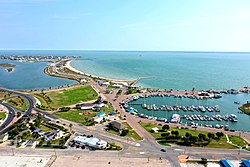
Aransas County is a county located in the U.S. state of Texas. It is in South Texas and its county seat is Rockport.
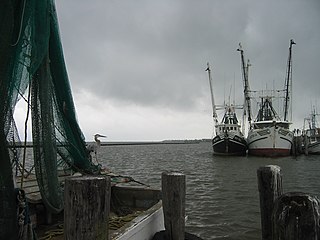
Fulton is a town in Aransas County, Texas, United States. As of the 2010 census, this South Texas coastal fishing community had a population of 1,358. The town is named for George Ware Fulton, a land developer in the area.

Port Lavaca is a city in Calhoun County, located in the U.S. state of Texas. The population was 12,248 at the 2010 census and 11,557 at the 2020 census. It is the county seat of Calhoun County and part of the Port Lavaca, Texas micropolitan statistical area. Port Lavaca is 130 miles (210 km) southwest of Houston.
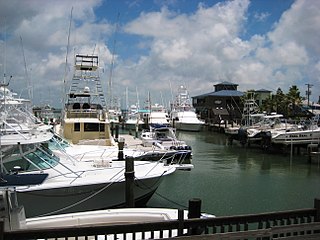
Port Aransas is a city in Nueces County, Texas, United States. This city is 180 miles southeast of San Antonio. The population was 2,904 at the 2020 census. Port Aransas is the only established town on Mustang Island. It is located north of Padre Island and is one of the longest barrier islands along the Texas coast. Corpus Christi Bay, the Gulf of Mexico, the Lydia Ann Ship Channel, and the Corpus Christi Ship Channel make up the surrounding waters.
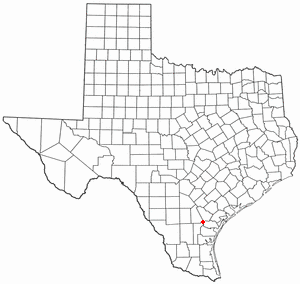
Mathis is a city in San Patricio County, Texas, United States. The population was 4,942 at the 2010 census.
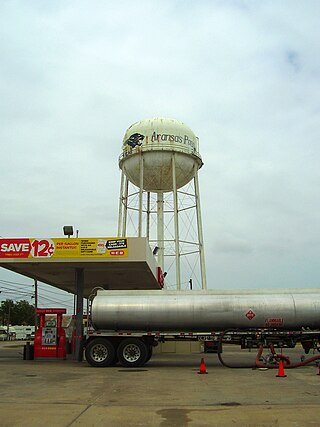
Aransas Pass is a city in Aransas, Nueces, and San Patricio Counties in the U.S. state of Texas. The population was 8,011 at the 2021 Census.

Corpus Christi is a coastal city in the South Texas region of the U.S. state of Texas and the county seat and largest city of Nueces County with portions extending into Aransas, Kleberg, and San Patricio counties. It is 130 miles (210 km) southeast of San Antonio and 208 miles (335 km) southwest of Houston. Its political boundaries encompass Nueces Bay and Corpus Christi Bay. Its zoned boundaries include small land parcels or water inlets of three neighboring counties.

Hurricane Celia was the costliest tropical cyclone in Texas history until Hurricane Alicia in 1983. The third named storm, second hurricane, and first major hurricane of the 1970 Atlantic hurricane season, Celia developed from a tropical wave in the western Caribbean Sea on July 31. Initially, the depression tracked north-northwestward without significantly strengthening, and crossed over western Cuba on August 1. Heavy rains on the island caused severe flooding, leading to five fatalities. The depression entered the Gulf of Mexico and was upgraded to Tropical Storm Celia later on August 1. Due to warm sea surface temperatures, Celia rapidly intensified into a major hurricane on August 1 and after the creation of the Saffir–Simpson hurricane wind scale in 1971 it was estimated to have been a Category 3 storm. Storm surge and swells lashed the west coast of Florida, especially the Panhandle, causing eight people to drown. Early on August 2, Celia began to weaken. However, the storm underwent rapid deepening again and peaked as a Category 4 hurricane with winds of 140 mph (220 km/h) on August 3.

Aransas Bay is a bay on the Texas Gulf Coast, approximately 30 miles (48 km) northeast of Corpus Christi, and 173 miles (278 km) south of San Antonio. It is separated from the Gulf of Mexico by San José Island. Aransas Pass is the most direct navigable outlet into the Gulf of Mexico from the bay. The cities of Aransas Pass and Port Aransas are located at the southern end, and Rockport is found on the central western shore. The bay is oriented laterally northeast–southwest, and is extended by Redfish Bay to the southwest, Copano Bay to the west, Saint Charles Bay to the north, and Mesquite Bay to the northeast. Aransas Bay is part of the Mission-Aransas National Estuarine Research Reserve.

The "Big Tree", near the town of Rockport, Texas, is one of the most famous live oaks in the world after being named "Texas State Champion Virginia Live Oak" in 1969. The tree retained that title until 2003, when a larger oak was discovered in Brazoria County, Texas. The "Big Tree" is still thought to be one of the largest live oak specimens in the United States.

The 1916 Texas hurricane was an intense and quick-moving tropical cyclone that caused widespread damage in Jamaica and South Texas in August 1916. A Category 4 hurricane upon landfall in Texas, it was the strongest tropical cyclone to strike the United States in three decades. Throughout its eight-day trek across the Caribbean Sea and Gulf of Mexico, the hurricane caused 37 fatalities and inflicted $11.8 million in damage.
Rockport-Fulton Independent School District, formerly Aransas County Independent School District, is an independent county-wide school district based in Rockport, Texas, United States. The district serves a 486-square-mile (1,260 km2) area that covers most of Aransas County, including the city of Rockport, the town of Fulton, and the unincorporated communities of Holiday Beach and Lamar.

The Corpus Christi metropolitan statistical area is a metropolitan area in South Texas that covers two counties, Nueces, and San Patricio. As of the 2000 census, the MSA had a population of 413,280.
The Corpus Christi–Kingsville–Alice Combined Statistical Area is made up of six counties in South Texas. The statistical area consists of the Corpus Christi Metropolitan Statistical Area, the Kingsville Micropolitan Statistical Area, and the Alice Micropolitan Statistical Area. As of the 2010 census, the CSA had a population of 501,500.

Copano Bay is a northwestern extension of Aransas Bay, west of Rockport, Texas in Refugio and Aransas counties. It is supplied with seawater from the Gulf of Mexico via Aransas Bay, and fed freshwater from the Aransas River, Mission River and Copano Creek. As an estuary, the bay is home to a diverse ecosystem consisting of various birds including the endangered whooping crane, and numerous finfish including the redfish as well as shellfish such as oysters. It is classified as a nursery for shrimp, which prohibits production from the bay. Copano Bay is also a historic location for human usage and settlement that dates back to the 18th century, beginning with the historic port of El Copano and the 19th century settlements of St. Mary's of Aransas and Copano. The present-day towns of Bayside, Copano Village and Holiday Beach were all founded in the 20th century. Oil and natural gas are pumped from below the bay's surface, and contribute to the livelihood of the local economies. Recently, areas around the bay were affected by Hurricane Harvey which crossed over the bay as a Category 3 hurricane.
Lamar is a small, unincorporated community and census-designated place (CDP) in Aransas County, Texas, United States, 10 miles (16 km) north of Rockport and 40 miles (64 km) north of Corpus Christi. As of the 2010 census it had a population of 636. The community was named for Mirabeau B. Lamar, the second president of the Republic of Texas. This was a new CDP for the 2010 census.
Holiday Beach is an unincorporated community and census-designated place in Aransas County, Texas, United States. As of the 2010 census it had a population of 514. This was a new CDP for the 2010 census.
St. Mary's of Aransas is a ghost town near the present community of Bayside in Refugio County, Texas, United States. It served as a settlement and major port until the emergence of Rockport in the late 19th century.

Hurricane Harvey was a devastating Category 4 hurricane that made landfall on Texas and Louisiana in August 2017, causing catastrophic flooding and more than 100 deaths. It is tied with 2005's Hurricane Katrina as the costliest tropical cyclone on record, inflicting $125 billion in damage, primarily from catastrophic rainfall-triggered flooding in the Houston metropolitan area and Southeast Texas; this made the storm the costliest natural disaster recorded in Texas at the time. It was the first major hurricane to make landfall in the United States since Wilma in 2005, ending a record 12-year span in which no hurricanes made landfall at the intensity of a major hurricane throughout the country. In a four-day period, many areas received more than 40 inches (1,000 mm) of rain as the system slowly meandered over eastern Texas and adjacent waters, causing unprecedented flooding. With peak accumulations of 60.58 in (1,539 mm), in Nederland, Texas, Harvey was the wettest tropical cyclone on record in the United States. The resulting floods inundated hundreds of thousands of homes, which displaced more than 30,000 people and prompted more than 17,000 rescues.

Hurricane Harvey caused major flooding in southern Texas for four days in August 2017. Hurricane Harvey formed on August 17, 2017 in the open Atlantic. Six days later, after degenerating back into a tropical wave and moving through the Caribbean Sea, Harvey reformed and rapidly intensified in the Gulf of Mexico. Early on August 26, Harvey made landfall in San José Island, Texas at peak intensity as a Category 4 hurricane with winds of 130 mph and a pressure of 937 mb. A couple of hours Harvey made another landfall in Holiday Beach as a slightly weaker high-end Category 3 storm. After that, Harvey rapidly weakened and stalled for multiple days over Texas, dropping torrential rainfall. Harvey eventually moved back into the Gulf on August 28, and a day later, Harvey made a fifth and final landfall west of Cameron, Louisiana.
